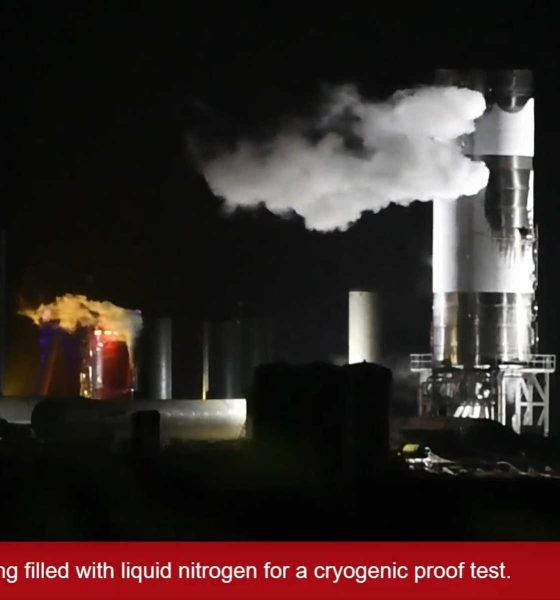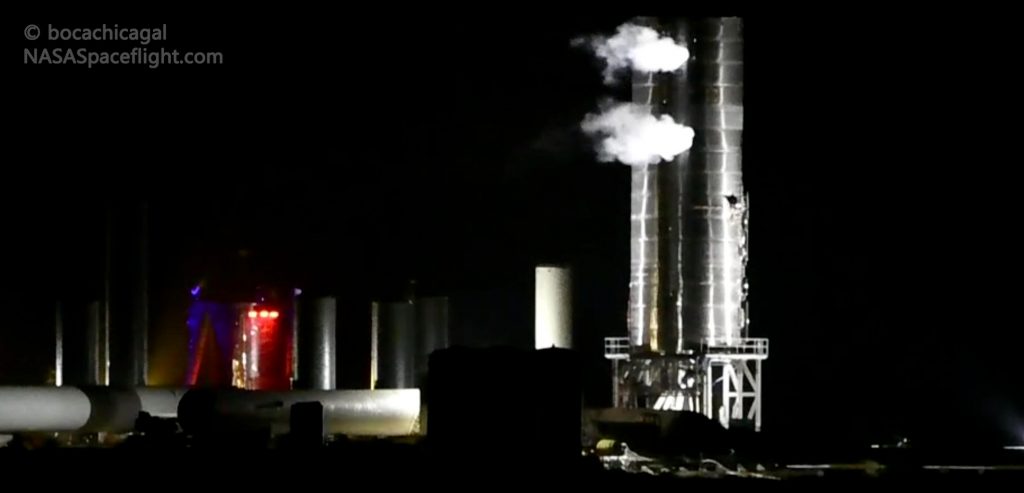

News
SpaceX Starship prototype kicks off gauntlet of tests for the fifth time
Hours after a successful Falcon 9 launch, a SpaceX Starship prototype has kicked off a challenging gauntlet of tests for the fifth time in hopes of becoming the first to take flight.
Five days after the ~30m (~100 ft) tall steel rocket was transported from the factory to the launch pad, SpaceX has fully integrated it with a brand new launch mount – built from scratch after operator error caused Starship SN4 to explode and destroy the prior mount. Assembled and outfitted with great haste, the new mount was completed just a day or two before Starship SN5 was moved to the pad and installed on top of it.
Triggered by a quick disconnect umbilical panel fuel leak that effectively caused a bomb-like fuel-air explosion, Starship SN4’s May 29th demise occurred shortly after a Raptor static fire test that was likely one of the last hurdles standing between SpaceX and the first full-scale Starship flight test. That fated static fire itself occurred a single day after SpaceX crossed a major regulatory milestone with an official FAA launch license for an effectively unlimited number of suborbital Starship flights. Now transformed into a pile of scorched scrap metal, Starship SN4 has passed the torch to Starship SN5.
Effectively identical to the gauntlet of tests Starship SN4 completed in the weeks prior to its destruction, Starship SN5 has kicked off its own test campaign with an ambient pressure test – a low-risk method of checking a pressure vessel for leaks. Starship SN5 apparently passed that first test without issue and SpaceX is now in the midst of loading the rocket tank section with cryogenic liquid nitrogen as a chemically neutral and nonexplosive stand-in for live liquid oxygen and methane propellant. (SN4 serves as a perfect illustration of why initial cryo proof tests are performed with LN2 instead of real propellant.)
SN4 was actually the first full-scale Starship prototype to survive a full cryogenic proof test, achieving 7.5 bar (~110 psi), so SN5’s success is far from guaranteed. Still, given SpaceX’s iterative, clockwork-like approach to development means that it’s far more likely than not that Starship SN5 will pass all the tests that its predecessor did – and then some.

If Starship SN5’s cryo proof is successful, SpaceX has a few options available. Depending on the level of confidence in SN5, SpaceX could proceed directly into installing a single Raptor engine on the rocket’s triple-engine thrust structure and move on to wet dress rehearsals (WDRs) with methane and oxygen propellant. If a more cautious approach is preferred, SpaceX could perform a WDR or two before installing a Raptor engine. Either way, once the WDR phase is complete, Starship SN5 can begin live Raptor engine testing, starting with turbopump prime and preburner tests and culminating in one or several static fires.
Finally, once preburner and static fires have been completed without issue, SpaceX can begin to seriously prepare SN5 for its inaugural hop test, likely targeting an altitude of ~150m (~500 ft) before landing a few hundred feet from the launch mount. For now, many steps remain in the interim before Starship SN5 is even close to a hop test, but it shouldn’t take long to find out how long we’ll have to wait.
Check out Teslarati’s Marketplace! We offer Tesla accessories, including for the Tesla Cybertruck and Tesla Model 3.

News
Tesla starts showing how FSD will change lives in Europe
Local officials tested the system on narrow country roads and were impressed by FSD’s smooth, human-like driving, with some calling the service a game-changer for everyday life in areas that are far from urban centers.

Tesla has launched Europe’s first public shuttle service using Full Self-Driving (Supervised) in the rural Eifelkreis Bitburg-Prüm region of Germany, demonstrating how the technology can restore independence and mobility for people who struggle with limited transport options.
Local officials tested the system on narrow country roads and were impressed by FSD’s smooth, human-like driving, with some calling the service a game-changer for everyday life in areas that are far from urban centers.
Officials see real impact on rural residents
Arzfeld Mayor Johannes Kuhl and District Administrator Andreas Kruppert personally tested the Tesla shuttle service. This allowed them to see just how well FSD navigated winding lanes and rural roads confidently. Kruppert said, “Autonomous driving sounds like science fiction to many, but we simply see here that it works totally well in rural regions too.” Kuhl, for his part, also noted that FSD “feels like a very experienced driver.”
The pilot complements the area’s “Citizen Bus” program, which provides on-demand rides for elderly residents who can no longer drive themselves. Tesla Europe shared a video of a demonstration of the service, highlighting how FSD gives people their freedom back, even in places where public transport is not as prevalent.
What the Ministry for Economic Affairs and Transport says
Rhineland-Palatinate’s Minister Daniela Schmitt supported the project, praising the collaboration that made this “first of its kind in Europe” possible. As per the ministry, the rural rollout for the service shows FSD’s potential beyond major cities, and it delivers tangible benefits like grocery runs, doctor visits, and social connections for isolated residents.
“Reliable and flexible mobility is especially vital in rural areas. With the launch of a shuttle service using self-driving vehicles (FSD supervised) by Tesla in the Eifelkreis Bitburg-Prüm, an innovative pilot project is now getting underway that complements local community bus services. It is the first project of its kind in Europe.
“The result is a real gain for rural mobility: greater accessibility, more flexibility and tangible benefits for everyday life. A strong signal for innovation, cooperation and future-oriented mobility beyond urban centers,” the ministry wrote in a LinkedIn post.
News
Tesla China quietly posts Robotaxi-related job listing
Tesla China is currently seeking a Low Voltage Electrical Engineer to work on circuit board design for the company’s autonomous vehicles.

Tesla has posted a new job listing in Shanghai explicitly tied to its Robotaxi program, fueling speculation that the company is preparing to launch its dedicated autonomous ride-hailing service in China.
As noted in the listing, Tesla China is currently seeking a Low Voltage Electrical Engineer to work on circuit board design for the company’s autonomous vehicles.
Robotaxi-specific role
The listing, which was shared on social media platform X by industry watcher @tslaming, suggested that Tesla China is looking to fill the role urgently. The job listing itself specifically mentions that the person hired for the role will be working on the Low Voltage Hardware team, which would design the circuit boards that would serve as the nervous system of the Robotaxi.
Key tasks for the role, as indicated in the job listing, include collaboration with PCB layout, firmware, mechanical, program management, and validation teams, among other responsibilities. The role is based in Shanghai.
China Robotaxi launch
China represents a massive potential market for robotaxis, with its dense urban centers and supportive policies in select cities. Tesla has limited permission to roll out FSD in the country, though despite this, its vehicles have been hailed as among the best in the market when it comes to autonomous features. So far, at least, it appears that China supports Tesla’s FSD and Robotaxi rollout.
This was hinted at in November, when Tesla brought the Cybercab to the 8th China International Import Expo (CIIE) in Shanghai, marking the first time that the autonomous two-seater was brought to the Asia-Pacific region. The vehicle, despite not having a release date in China, received a significant amount of interest among the event’s attendees.
Elon Musk
Elon Musk and Tesla AI Director share insights after empty driver seat Robotaxi rides
The executives’ unoccupied tests hint at the rapid progress of Tesla’s unsupervised Robotaxi efforts.

Tesla CEO Elon Musk and AI Director Ashok Elluswamy celebrated Christmas Eve by sharing personal experiences with Robotaxi vehicles that had no safety monitor or occupant in the driver’s seat. Musk described the system’s “perfect driving” around Austin, while Elluswamy posted video from the back seat, calling it “an amazing experience.”
The executives’ unoccupied tests hint at the rapid progress of Tesla’s unsupervised Robotaxi efforts.
Elon and Ashok’s firsthand Robotaxi insights
Prior to Musk and the Tesla AI Director’s posts, sightings of unmanned Teslas navigating public roads were widely shared on social media. One such vehicle was spotted in Austin, Texas, which Elon Musk acknowleged by stating that “Testing is underway with no occupants in the car.”
Based on his Christmas Eve post, Musk seemed to have tested an unmanned Tesla himself. “A Tesla with no safety monitor in the car and me sitting in the passenger seat took me all around Austin on Sunday with perfect driving,” Musk wrote in his post.
Elluswamy responded with a 2-minute video showing himself in the rear of an unmanned Tesla. The video featured the vehicle’s empty front seats, as well as its smooth handling through real-world traffic. He captioned his video with the words, “It’s an amazing experience!”
Towards Unsupervised operations
During an xAI Hackathon earlier this month, Elon Musk mentioned that Tesla owed be removing Safety Monitors from its Robotaxis in Austin in just three weeks. “Unsupervised is pretty much solved at this point. So there will be Tesla Robotaxis operating in Austin with no one in them. Not even anyone in the passenger seat in about three weeks,” he said. Musk echoed similar estimates at the 2025 Annual Shareholder Meeting and the Q3 2025 earnings call.
Considering the insights that were posted Musk and Elluswamy, it does appear that Tesla is working hard towards operating its Robotaxis with no safety monitors. This is quite impressive considering that the service was launched just earlier this year.








